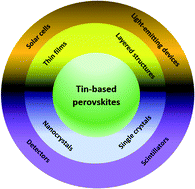Tin-based halide perovskite materials: properties and applications
Abstract
Organic–inorganic hybrid halide perovskite materials have attracted considerable research interest, especially for photovoltaics. In addition, their scope has been extended towards light-emitting devices, photodetectors, or detectors. However, the toxicity of lead (Pb) element in perovskite compositions limits their applications. Therefore, a tremendous research effort on replacing is underway. More specifically, tin-based perovskites have shown the highest potential for this purpose. However, many challenges remain before these materials reach the goals of stability, safety, and eventually commercial application. This perspective considers many aspects and the critical development possibilities of tin-based perovskites, including drawbacks and challenges based on their physical properties. Additionally, it provides insights for future device applications that go beyond solar cells. Finally, the existing challenges and opportunities in tin-based perovskites are discussed.

- This article is part of the themed collections: Most popular 2022 materials and energy articles and 2022 Chemical Science Perspective & Review Collection


 Please wait while we load your content...
Please wait while we load your content...